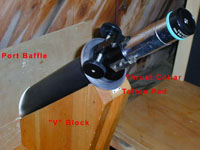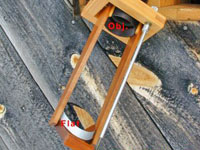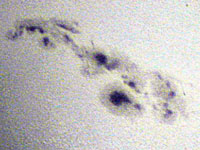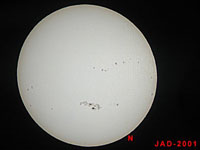



Additional photos are
available on Jim's page in the Astro Image Gallery.
|
by Jim Daley, STM, of New Hampshire
2001-Jun-25
If you have a garden shed or a south facing home window then a nice little solar observatory
is but a few pleasant atm hours away. This little observing gem is based on the Gerrish Polar Mount. I have been
observing sun spots in white light with this arrangement for many years and can tell you that no other solar
projector design has pleased me so much. The Gerrish mount places a refracting telescope's optical axis
coincident with the polar axis about which the tube rotates carrying the eyepiece etc. around with it. Just a
ways in front of the aperture is an optical flat that reflects the sun into the objective. The flat is attached
to the tube thus is carried around giving right ascension pointing. The flat is adjustable on an axis
perpendicular to the polar motion for declination setting. If you view the annotated photographs below a good
idea can be had as to how it all works.
This Solar Gerrish is built into the south wall of my backyard observatory and projects the
image upward along the polar axis to a hinged screen which is swung down from it's stored position in the
rafters. Because the observing room is dark you sit inside the camera and enjoy incredibly contrasty images,
just like the Porter Turret solar projection arrangement. The wind can be howling but the image stays vibration
free due to the stiff nature of the Gerrish type and the small area exposed to wind loading. In the biggest
puffs one observes the image shift slightly as the building flexes but no harmful image jitter is ever seen. I
track the sun by gently twisting the tube in RA on it's Teflon, "V" block supported, bearing pads. The screen is
two feet in diameter and the image size used most of the time is around 14-inches so the time between
adjustments is long enough for good views. Image (field) rotation moves the north point around the screen as the
day progresses, however, the drift direction lets the observer determine east and north easily. With a clear
aperture of only 2-inches you would think the resolution a bit low but in actual practice it seems to be a good
all-round size for this sort of scope. Only rarely is the seeing so good that a bigger aperture could prove
useful. In the best seeing, surface mottling and linear penumbra features can be detected and faculae are
beautifully defined. To vary the image size the eyepiece is changed for one of another focal length just as in
any projection set-up.
Lately, a digital camera has been used to record the projected image and a sample photo is
included here. One problem that shows up when photographing is the specular reflection off the screen showing up
in the photo because, to get a fairly circular image, you need to position the camera (close beside the
eyepiece) as normal as possible to the screen. This is avoided visually because the viewing angle is a somewhat
to the side. I may try an old idea which employs a cast dental stone screen.
The instrument can be used in a direct view manner with appropriate, solar, aperture filters.
Viewing this way is quite comfortable as you are seated and look down the polar axis. At night, the views of
moon and planets are pleasing and provides something to do while the CCD Schmidt is cranking out a long
exposure. After observing, the scope is lifted off the "V" block and put into a specially made storage box and
then the wall port is closed with a down swinging door. Construction wise, the photos in this article should
give the TN enough information, keeping in mind that every installation will reflect the builders site and
optical "junk box". I should mention that the flat (a very high quality 2.25-inch elliptical diagonal in my
version) is used at a large angle of incidence and must be really good to avoid astigmatism. Try to get 1/10
wave or better flatness. The mid-winter sun is so low that the aperture is not quite filled in my instrument.
This does not seem to hurt the image too much, however, a flat with a long dimension about 1.8 times the
aperture is preferred in any Gerrish system. As to the telescope: many nice inexpensive refractors are available
in the 60mm size. Even some of the dept. store "500 power" jobs (swap tables are often piled high with them)
sometimes have pretty good objectives and with a high quality eyepiece substituted, your on your way to a neat
Solar Observatory!
For another version of a polar mounted solar projection telescope see: Sky & Telescope,
September,1963 Gleanings For ATM's "A Polar Telescope For Visual Solar Work" by B. C. Parmenter.
|